Updated: 21-Oct-2020
Well-known brand of rotary engines from the First World War, named after the place where they were manufactured, in Oberursel, near Frankfurt.
-Years later its facilities served the Deutz and then the Klockner-Humboldt-Deutz (KHD).

“Oberursel U-I”
-After a visit to the Munich Museum, we saw a U-I whose photograph we show below.
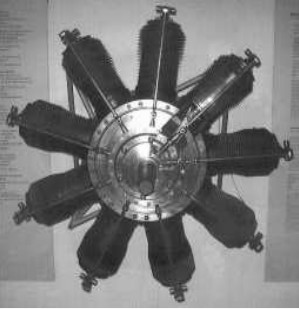
“Oberursel U-I”
-The U-0 gave 80 CV. The U-I with 9 cylinders, delivered 100 CV. Here it is represented first in a side view in which we can see the two fittings that hold the fuselage and the propeller integral with the rotating casing. And below it a frontal view.
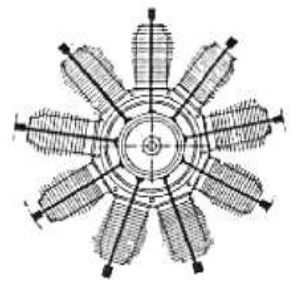
“Oberursel U-I, front drawing”
Firstly, they built the French Gnome and Le-Rhone engines, the Lambda, Double Lambda and Monosoupape models under license that was obtained before 1914.

“Oberursel UR-II”
-The U-II had 9 cylinders and gave 110 CV. The UR-II variant (sometimes UR-2) also gave 110 CV, as early as 1918.
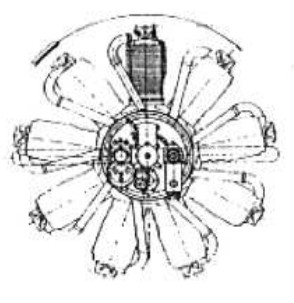
"Oberursel UR-2, rear view"
-The rear shaft of the engine that supports the bearings where the block rotates, has a crankshaft journal inside the motor and at the rear end there is the carburetor.
-This shaft is hollow and the mixture of gasoline and oil with the air passes through its interior.
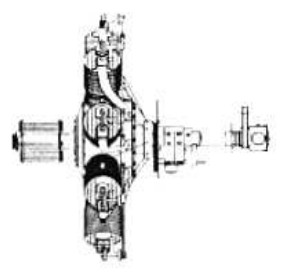
“UR-2, side view”
-This shaft has two fixed supports, sometimes in the form of discs, one towards the middle of the engine and the other one next to the carburetor. These discs provide the mounting bases for the aircraft cell.
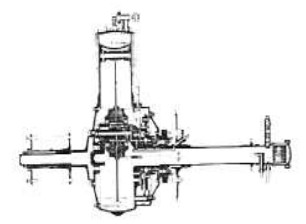
“UR-2, cross-section”
-Below there is a rear-view drawing of the UR-2 with the complete cylinders including the fins.

“UR-2”
-It is said that at the end of the war there was a shortage of Castor oil, so it only went to the elite squadrons, while the others received mineral oil, with which the engine gave slightly less performance.
-The UR-3 (sometimes named UR-III) was derived from this engine.
-This one had 11 cylinders and gave 145 CV. Not to be confused with the U-III, which had 14 cylinders in two rows.
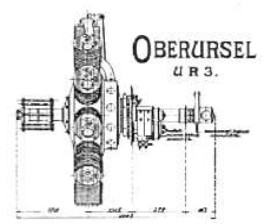
"Oberursel UR-III, 11-cylinder"
-There have not been many 11 cylinder engines in a single row. Throughout this A-Z publication we discovered a few, but at first there were serious doubts that they even existed.
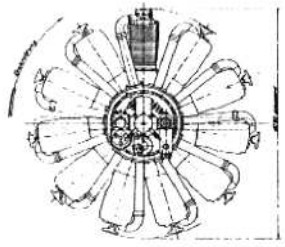
“UR-III”
The Siemens brand has another 11-cylinder and the French had their 11-cylinder Gnome. Stranger is though, that some text mentions that Oberursel made a double row of 11 cylinders, that is, 22 cylinders. This is not confirmed.
-The U-III was a good Oberursel engine, a 14-cylinder double row that delivered 160 CV.
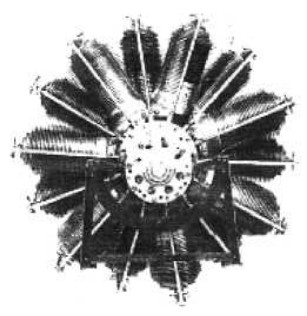
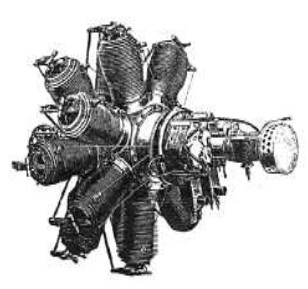
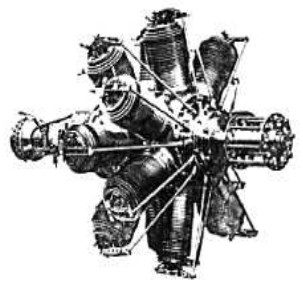
“U-III, three views”
-For its time, the appearance of the U-III was pleasant, since so much rotating mass required an identical construction of cylinders, pistons, etc. so that their weights, multiplied by the tangential speeds, will not cause vibrations.
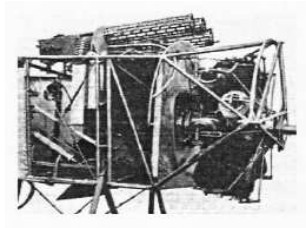
"U-III, installed in a cell"
-Finally we see the same U-III engine in a cross-section, in which we can see that the cam plates are only at the front of the engine.
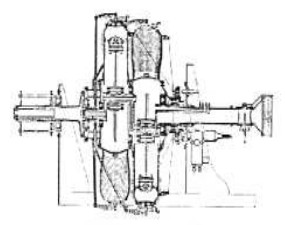
“U-III, cross-section”
-The rod on the front row has the normal angle while those of the rear row are more inclined. The mixture passes through the crankshaft to the rear block and from there to the front.
From Appendix 9: Aviation engine factory named after the city where it was located. After many vicissitudes in little more than a century, today it is in the hands of Rolls-Royce Deutschland.
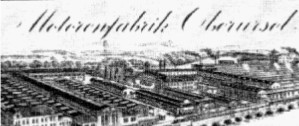
“From an Oberursel brochure”
-The history of the factory dates back to 1847 for the construction of grinding wheels. There was a lapse of use by a buyer in Frankfurt who used it for chicken farming.
-Sold again it became a foundry and machinery manufacturing (1883). They started making engines in 1890.
-Precisely one of these engines, a 4-stroke giving 4 CV, very small but powerful for its size, was called "GNOM" and was said to correspond to "Geht Nicht Ohne Monteur" (in English, Won’t Work Whitout Mechanic).
-This engine was built by the Seguin brothers in Lyon (France) by an agreement with the Oberursel factory, it was the year 1900.
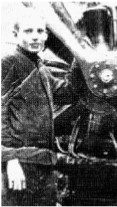
“From the same brochure: RR-Deutschland” (PiP)
-When eight years later (1908) the Seguin brothers made the radial rotary and named it GNOME -in deference to Gnom, in an explanation of the Germans-. The engine was presented that year at the Paris Air Show.
-The author has thus discovered another origin of the engine names as he did before with that of Mercedes with respect to the daughter of a Daimler representative on the French Riviera. Or that the Rolls-Royce Merlin engine is not the name of a magician but of a bird. Now we have that Gnome is not the name of a dwarf.
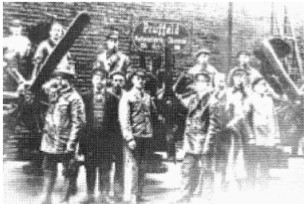
“Oberursel workers and engines”
-Richtoffen's Fokker DR-1 triplane carried a 9-cylinder Oberursel. After WWI in 1919, they built bicycles and small engines for cars and motorcycles like the Horex.
-Oberursel is bought by Deutz AG to build 2-stroke engines. Also in 1919.
-In 1923 they made industrial and ship engines. Generators and auxiliary groups. In 1930 it was renamed Humbolt-Deutz Motoren AG.
-In 1938 they joined Klockner AG gathering the names, (by contraction KHD). And it is in 1940 when the 8-cylinder DZ-700 engines are built. Diesel aviation radials and the DZ-710, a 16-cylinder boxer and the DZ-720 with 32 cylinders in H. These are all 2-stroke Diesel. In 1945 the victorious USA secretly took away all the material.
-KHD is recovered in 1956, building the Bristol Orpheus for the Fiat G-91 the following year. They also made the T-112 turbine for the vertical take-off VAK aircraft.
-In 1964 Rolls-Royce entered with the Industrial Proteus, the T-212 for the Kiebitz, and the T312 for the Tornado APU, etc.
-The 14-cylinder rotary U-III was located in the Munich museum.
-It is provided here for a possible replacement of those that appear in the main text. Photos E.V.
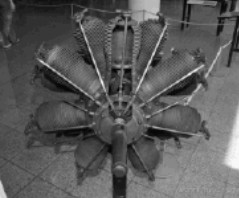
“U-III with one cutaway cylinder”
-Observing carefully we see that the visible piston has a cut skirt and it also has a Gnome-type overhead valve. Oberursel worked with licenses.

“Oberursel U-III, rear view” (E.V.)
-We can see the ignition cables towards the spark plugs.
-The side view below shows the counterbalanced rocker arms (so that they are centrifuged and the tappets sit on the cam plate). Besides it lifts the exhaust valve closing it. The spring action strap that favors the above can also be seen.

“U-III side view”
Engines of OBERURSEL
Model: U.I
Arquitecture: 9-cylinder Rotary
Cooling: Air
Total Displacement:
Bore / Stroke:
Power: 100 CV
Weight:

"Oberursel U-I, photo"
Model: U.III
Arquitecture: 11-cylinder Rotary
Cooling: Air
Total Displacement:
Bore / Stroke:
Power: 145 CV
Weight:

"Oberursel U-III, front view"
Model: U.O
Arquitecture: Rotary
Cooling:
Total Displacement:
Bore / Stroke:
Power: 80 CV
Weight:
Model: Ur.II
Arquitecture: 9-cylinder Rotary
Cooling: Air
Total Displacement:
Bore / Stroke:
Power: 110 CV
Weight:

"Oberursel UR-II"
Model: Ur.III
Arquitecture: 14-cylinder Rotary
Cooling: Air
Total Displacement:
Bore / Stroke:
Power: 160 CV
Weight:

"Oberursel UR-III, drawing"


